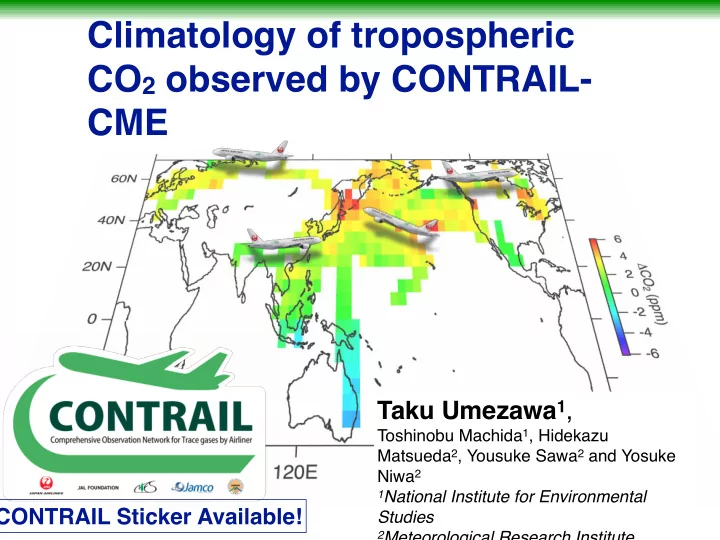

Climatology of tropospheric CO 2 observed by CONTRAIL- CME Taku Umezawa 1 , Toshinobu Machida 1 , Hidekazu Matsueda 2 , Yousuke Sawa 2 and Yosuke Niwa 2 1 National Institute for Environmental CONTRAIL Sticker Available! Studies 2 Meteorological Research Institute
What we see in the free troposphere 250 hPa NICAM model illustrates how a source signal propagates in the atmosphere. Surface Niwa et al. (2012, JGR) CONTRAIL CME data for 2005–2010: • Number of flight ~5000 • Number of CME data ~3 millions • Analysis grid 20° x 10° • Vertical gradient was not analysed in detail. Sawa et al. (2012, JGR)
Motivation • Distribution of CO 2 in the atmosphere is key information for better understanding of the global carbon cycle. • Latitudinal gradient (e.g. Denning et al. 1995) • Vertical gradient (e.g. Stephens et al. 2007) • There are data-scarce regions where stable station measurements are still almost infeasible . • CONTRAIL can fill the data gap extensively. —and the data have been indeed used to infer surface fluxes (e.g. Niwa et al. 2012; Basu et al. 2014; Zhang et al. 2015). • Yet complete description of the CONTRAIL-provided atmospheric CO 2 distribution (including updates and more of Sawa et al. 2008, 2012) has not be given. • In this presentation, we focus on CONTRAIL data in Asia-Pacific regions .
CONTRAIL Project since 2005 Comprehensive Observation Network for Trace gases by Airliner � Forward'Cargo'Room � Af � 'Cargo'Room � ASE: Automatic Air Sampling Equipment, CME: Continuous CO 2 for CO 2 , CH 4 , CO, N 2 O, SF 6 , H 2 , isotopes Measuring Equipment
An example of CME data 1 data per 10 sec during ascent/descent 1 data per 1 min during level flight
Flight routes with CME (Nov. 2005–Dec. 2014) ~12,000 flights ~23,000 vertical profiles ~7.0 million data 1. NRT , Japan 7270 2. HND , Japan 2937 3. SYD , Australia 1581 4. HNL , Hawaii 1455 5. BKK , Thailand 1273 6. NGO , Japan 855 7. DEL , India 787 8. SIN , Singapore 686 9. CDG , France 683 10. KIX , Japan 635 11. YVR , Canada 440 12. CGK , Indonesia 422 13. DME , Russia 409 14. SFO , California 366 15. AMS , the Netherlands 238 16. ICN , South Korea 199 17. LHR , UK 196 18. FUK , Japan 189
Δ CO 2 = CO 2 ( CONTRAIL NRT ) - CO 2 trend at MLO Decrease in summer Increase in winter–spring • Seasonal cycle of CO 2 is not vertically uniform (altitude dependent). • Vertical gradient of CO 2 varies seasonally.
Δ CO 2 composite analysis over Tokyo, Japan Vertical gradient varies with season: - large in winter - vertically uniform in summer.
Δ CO 2 over East Asia Seoul Tokyo Osaka Fukuoka East Asian pattern is characterised by Increase over winter–spring • Summer decrease pronounced • in the free troposphere
Δ CO 2 over Delhi, India 8–10 km DEL “Monsoon” Monsoon pre-Monsoon 4–6 km “East Asian pattern” 0–2 km
Distribution of annual average Δ CO 2 DME ✓ Large latitudinal gradient near the AMS LHR YVR CDG surface PEK ✓ Vertical gradient is large at mid ICN NRT etc. DEL SHA latitudes HKG HNL ✓ Opposite vertical gradients in the NH BKK and SH SIN CGK PEK NRT etc. SYD SHA ICN DEL HNL SYD ✓ Large Longitudinal gradient ✓ Vertical gradient is large in East YVR CDG AMS LHR BKK CGK HKG SIN Asia DME
Summary • Large number of the CONTRAIL CME data enables us to illustrate climatological distributions of tropospheric CO 2 , particularly for Asia/Pacific regions. • Seasonal cycles/vertical profiles are well characterised. • Different patterns are obvious at areas in upstream/ downstream of continental sources/sinks. • Extensive CO 2 data are available and can push data assimilation powerfully. • For data use, see the CONTRAIL website ! (Visit www.cger.nies.go.jp/contrail/ or google “CONTRAIL NIES”)
Recommend
More recommend